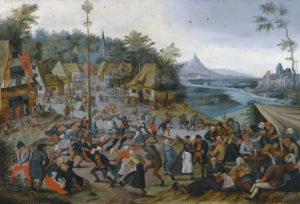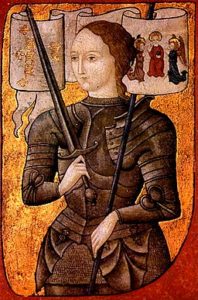Today begins the 59th year of the Society for Creative Anachronism! Be sure to set your scrolls forward to A. S. LIX.

St. George’s Kermis with the Dance around the Maypole

Today begins the 59th year of the Society for Creative Anachronism! Be sure to set your scrolls forward to A. S. LIX.

St. George’s Kermis with the Dance around the Maypole
Today begins the 58th year of the Society for Creative Anachronism! Be sure to set your scrolls forward to A. S. LVIII.

St. George’s Kermis with the Dance around the Maypole
We often think of the Battle of Agincourt from the English perspective; Henry V’s St. Crispins Day speech is just one of the mental images that Shakespeare indelibly etched on the history of that event, for better or worse.
By contrast, THL Lorraine Devereaux provides us with a collection of observations by a knight who was there — the French knight, Jehan de Wavrin. (The excerpts are from the book Eyewitness to History, by John Carey)
 On this day in 1429, a teenaged Jeanne d’Arc enters the besieged city of Orleans, rallying the French forces. By May 7 the French will break the siege, with Jeanne joining the armed forces on the field, holding her banner high.
On this day in 1429, a teenaged Jeanne d’Arc enters the besieged city of Orleans, rallying the French forces. By May 7 the French will break the siege, with Jeanne joining the armed forces on the field, holding her banner high.
Jeanne did not “lead” the armies. Noblemen commanders led their men on the field. However, many of these noblemen took the advice Jeanne offered them. Like the French king, the commanders believed her advice was divinely inspired. And Jeanne’s banner on the field brought hope to the French, who were losing badly to the invading English up until that time. During the year Jeanne was with the French army, it enjoyed more success than it had for years beforehand.
Jeanne will receive an arrow wound between her neck and shoulder during the May 7 battle, but it won’t deter her. She will return to the field in time to encourage the French forces to victory over the English.
 On this day in 1513, Spanish explorer Juan Ponce de Leon lands near present-day St. Augustine to explore the Florida coast. He was searching for a “Fountain of Youth,” a magical water source said to bring eternal youth. (He didn’t find it.)
On this day in 1513, Spanish explorer Juan Ponce de Leon lands near present-day St. Augustine to explore the Florida coast. He was searching for a “Fountain of Youth,” a magical water source said to bring eternal youth. (He didn’t find it.)
Ponce de Leon made a detailed exploration of what he thought was an island, and named it “La Florida” because he discovered it during the Easter “Pascua Florida,” or “Feast of Flowers” feast.
Ponce de Leon will return in 1521 and try to set up a permanent colony. However he will be wounded after a battle with Native Americans. His force will retreat to Cuba, where he will die.
 In 1356 the City of Bologna’s first city clock is unveiled. Installed in the Palazzo Capitanato at the Piazza, it strikes the hours for the first time on this day.
In 1356 the City of Bologna’s first city clock is unveiled. Installed in the Palazzo Capitanato at the Piazza, it strikes the hours for the first time on this day.
Since it was in Italy, the clock was set to “Italian time.” The first hour of the day was a half-hour after sunset. The hours proceeded clockwise around the clock face, with the 19th hour at about the spot where we would have 12. It struck the 24th hour about a half hour before sunset, ringing the bell or bells 24 times. The clock pictured here, which is still in Venice, is similar to the one Bologna had.
Italian time required the clock minders to reset the clock every three weeks or so because the days would grow longer or shorter, depending on the season. They had to lift and move the heavy iron clock works backwards or forwards so that the first hour rang a half-hour after sunset. Strange as this system was, it continued for a long time in Italy, Hungary and some other scattered places.
 A remarkable love letter, dated February 14, 1477, was written by Margaret Brews to her betrothed, John Paston. In it, she addresses John as “my ryght welbeloued Voluntyn,” making the letter the earliest known Valentine’s Day greeting.
A remarkable love letter, dated February 14, 1477, was written by Margaret Brews to her betrothed, John Paston. In it, she addresses John as “my ryght welbeloued Voluntyn,” making the letter the earliest known Valentine’s Day greeting.
On this day in 1542, King Henry VIII of England has his fifth wife, Catherine Howard, beheaded after two years of marriage.
On this day in 1497, Dominican friar Girolamo Savonarola and his supporters burned thousands of objects that were condemned as sinful. This included mirrors, cosmetics, fine clothing, playing cards, musical instruments, books, paintings and sculpture.
This was the best known, but not the only, or even the first such burning. They were known in Italian as falò delle vanità, or bonfire of the vanities.
You must be logged in to post a comment.